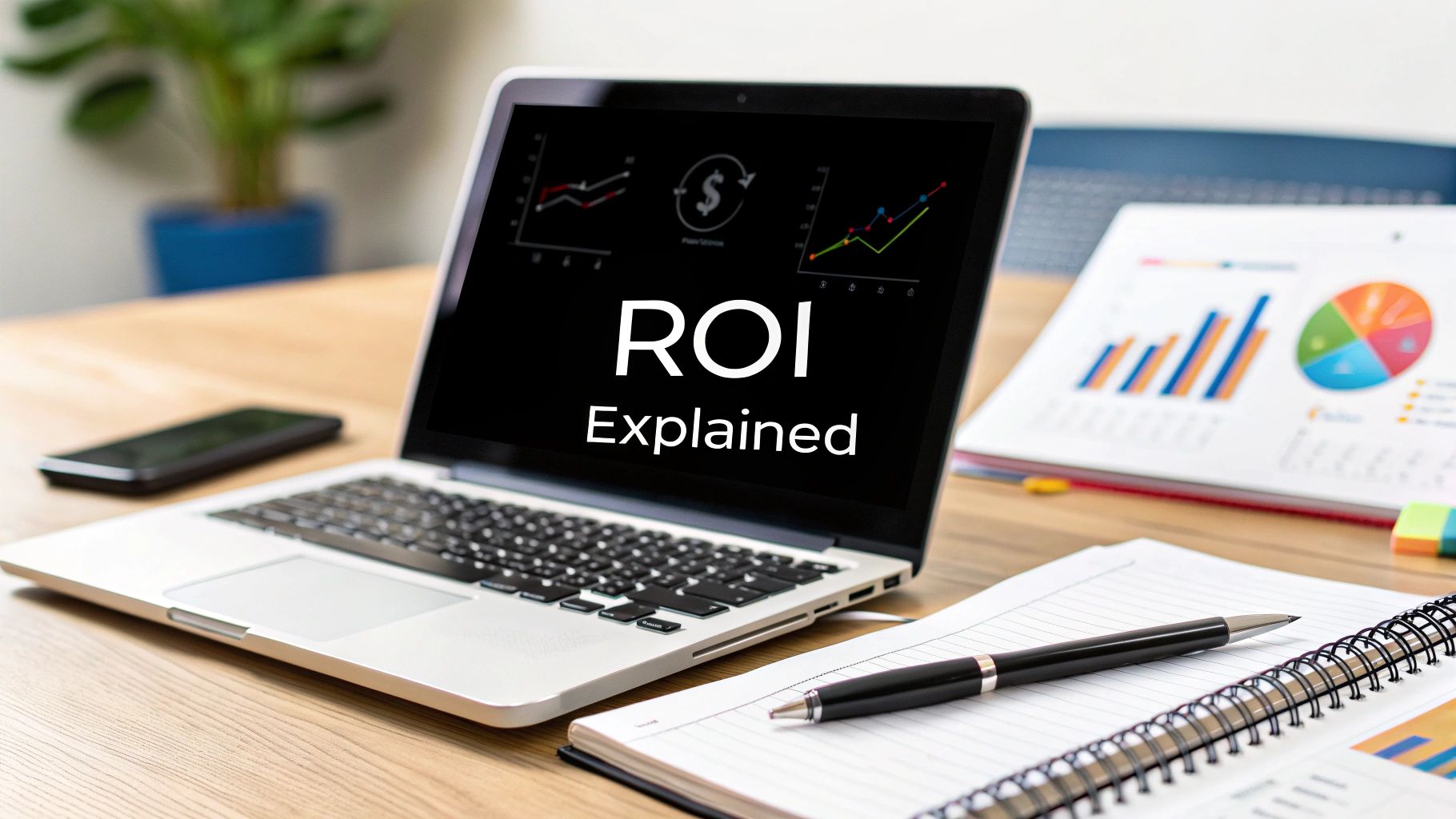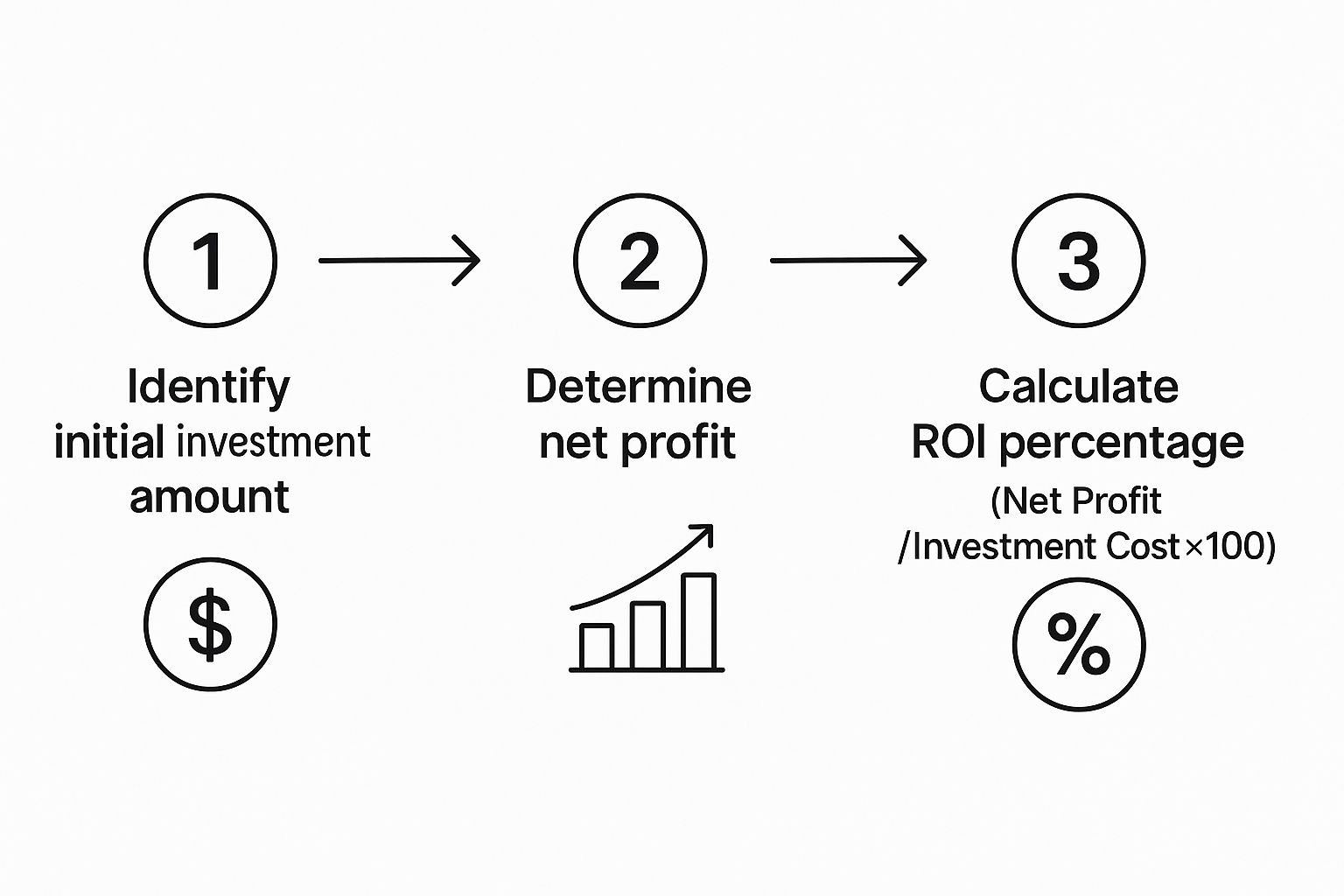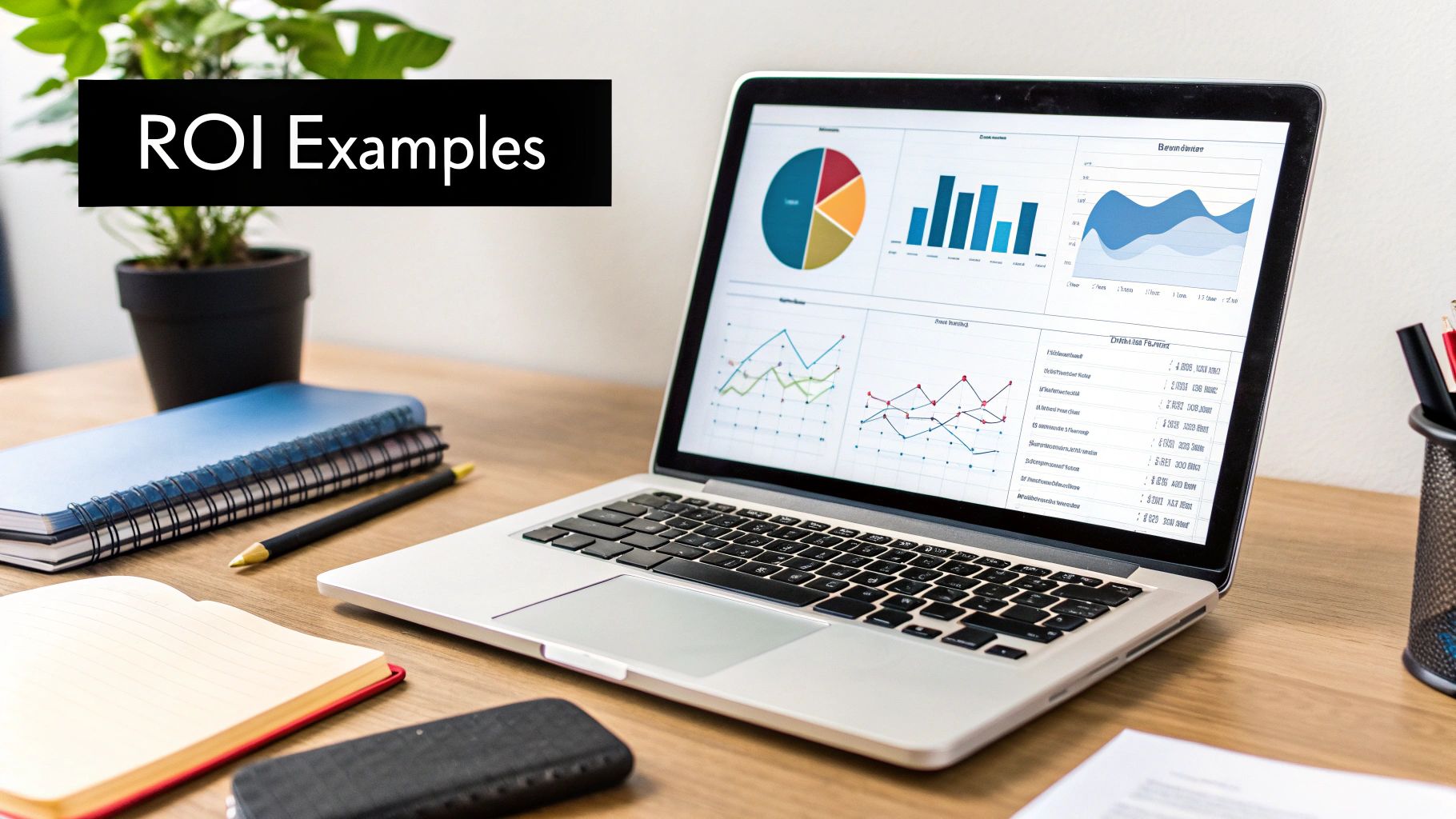August 20, 2025
What Is Return on Investment and How Do You Use It?


Return on Investment, or ROI for short, is a straightforward way to figure out if something you spent money on was actually worth it. In a nutshell, it answers the question: how much money did I make back compared to how much money I spent?
Think of it as a universal scorecard for just about any financial decision you make. It's a fundamental concept that helps you measure the profitability of an investment and compare the efficiency of different ventures. Getting this right is key.
What is Return on Investment (ROI)?
Ever launched a new ad campaign or bought a new piece of software and wondered, "Did that actually pay off?" That's the exact question ROI is designed to answer. It strips away all the complexity and gives you a straight, simple percentage to show whether you ended up in the green.
This little calculation is surprisingly powerful because it lets you compare totally different projects on an even playing field. For instance, was putting $1,000 into Google Ads a better move than spending that same $1,000 on a new email marketing tool? By turning the outcome into a percentage, ROI makes it crystal clear what's actually making you money and what's just eating up your budget.
Getting a handle on core business terms is always a good first step, and a clear definition of Return on Investment (ROI) provides a solid foundation.
ROI Concepts at a Glance
Here’s a quick summary of the fundamental parts of ROI to give you immediate clarity on the topic.
This table boils it down, but the real magic is seeing how these pieces work together.
Putting ROI into Perspective
So, what’s a “good” ROI? It really depends, but it helps to have a baseline to compare against. A common one is the stock market.
For decades, the S&P 500 has been a reliable benchmark for long-term growth. If you look back to 1957, its average annual return has hovered around 8.0% (assuming you reinvested the dividends). This doesn't mean you should expect 8.0% on everything, but it gives you a frame of reference for what a solid, long-term investment can look like.
Key Takeaway: At its core, ROI is about answering one simple question: "For every dollar I put in, how much did I get back?" It’s the ultimate metric for measuring success and making smarter decisions with your money.
How to Use the Simple ROI Formula
Okay, so you get the concept. But how do you actually do the math? Don't worry, calculating ROI isn't some high-level algebra problem. It’s a simple, back-of-the-napkin calculation designed to give you a quick and clear answer on whether something was worth the money.

The classic formula that everyone uses looks like this:
ROI (%) = (Net Profit / Cost of Investment) x 100
Let's break down what those terms really mean. You only need to hunt down two key numbers to make this work.
Defining the Two Key Parts
First, you have the Cost of Investment. This one's pretty straightforward. It’s simply the total amount of cash you put into the venture. Every single dollar you spent to get the thing off the ground counts.
Then there’s Net Profit. This is what you have left over after you’ve paid back your initial investment. To figure it out, just take the total money you brought in (the revenue or final value) and subtract what you originally spent.
- Cost of Investment: The total money you paid out.
- Net Profit: The final earnings minus that initial cost.
Getting a firm grip on your investment costs is key. For marketers, this often boils down to understanding how much it costs to get a new customer. If you want to go deeper on that, our guide on how to calculate cost per acquisition is a great place to start.
A Simple ROI Example
Let's put this into a real-world scenario. Say you stumble upon a cool vintage armchair at a flea market for $50. You see its potential.
You decide to fix it up, spending another $30 on new fabric and paint. After a bit of elbow grease, you sell it online for $200. Nice! So, what was the ROI?
Find Your Total Investment Cost:
Your cost wasn't just the chair itself; it was everything you spent.
$50 (for the chair) + $30 (for supplies) = $80 Total InvestmentFigure Out Your Net Profit:
This is what you pocketed after covering your costs.
$200 (sale price) - $80 (total investment) = $120 Net ProfitPlug it Into the ROI Formula:
Now we just pop those numbers into our formula.
ROI = ($120 / $80) x 100
ROI = 1.5 x 100
ROI = 150%
A 150% ROI is fantastic. It means that for every single dollar you put into that armchair project, you made that dollar back plus another $1.50 in pure profit. It’s a powerful number that tells you instantly that your little side hustle was a huge win. You can apply this exact same thinking to just about anything, from a Google Ads campaign to buying a new piece of software.
Why Calculating ROI Is a Game Changer
So, you’ve got the formula down for turning a business decision into a neat little percentage. But what do you actually do with that number? Knowing your return on investment is so much more than a math exercise; it’s the superpower that separates the businesses that guess from the ones that grow. It turns vague goals into solid, data-backed strategies.
Think of ROI as a universal translator for value. It lets you compare totally different opportunities on a level playing field. Without it, how would you possibly decide whether to spend $5,000 on a flashy new marketing campaign or on upgrading your team's software? They feel like apples and oranges, but ROI cuts right through the noise and tells you which option is likely to deliver more bang for your buck.
It’s this simple metric that empowers you to make smarter choices, confidently justify your budget requests, and prove the value of your work to anyone who asks.
Moving From Guesswork to Strategy
At its core, ROI forces you to think critically about both your costs and your outcomes. It flips your mindset from "we spent money on this" to "we invested money in this, and here’s exactly what we got back." That shift in perspective is absolutely fundamental for sustainable growth. It helps you see what's actually working and what's just a drain on your resources.
Calculating ROI is the first step toward creating a powerful feedback loop for your business. You make a decision, you measure the outcome, and then you use that data to make an even better decision next time. It’s how you learn, adapt, and ultimately, win.
This whole process of measuring and analyzing is what it's all about. By consistently tracking the return on your different investments, you can start to:
- Allocate Resources Effectively: You can funnel money into the channels and projects that actually deliver the highest returns. Why would you keep pouring cash into a marketing channel with a 25% ROI when another one is consistently bringing in 200%?
- Justify Spending: The next time you need to ask for a bigger budget, presenting a strong history of positive ROI is the most persuasive argument you can possibly make. The numbers don't lie.
- Improve Future Performance: Digging into past ROIs—both the wins and the losses—provides invaluable lessons. This is what sharpens your business instincts and makes your future forecasts far more accurate.
In the end, calculating ROI isn't just about looking backward at what you did. It’s about building a smarter, more predictable path forward for your business. It turns every dollar you spend into an opportunity to learn and grow, making it one of the most powerful tools in your entire arsenal.
Putting The ROI Formula To Work With Real Examples
Theory is one thing, but seeing the ROI formula in action is where it really clicks. Let's move past the basics and apply it to a few realistic scenarios you might actually run into. The logic doesn't change, whether you're sizing up a digital ad campaign, buying new software, or even hiring a new employee.
The trick is to be brutally honest and thorough when you add up your costs and gains. You have to account for everything to get a true picture of your return. It really proves that context is everything when you're trying to figure out your return on investment in the real world.
To kick things off, this simple visual breaks down the core process of any ROI calculation.

As you can see, it’s a straight shot from figuring out your total costs to calculating your net profit and, finally, getting that percentage.
Example 1: The Digital Ad Campaign
Picture this: you run an e-commerce store and decide to invest in a Google Ads campaign for a new product line. This is a classic scenario where ROI is king.
- Total Investment Cost: You spend $2,000 on ad clicks over one month.
- Total Revenue Generated: The campaign pulls in $7,000 in direct sales.
- Net Profit: $7,000 (Revenue) - $2,000 (Ad Spend) = $5,000
- ROI Calculation: ($5,000 / $2,000) x 100 = 250%
A 250% ROI means that for every single dollar you put into that campaign, you got that dollar back plus an extra $2.50 in profit. That’s a clear win. For anyone looking to get really good at this, our guide to managing PPC campaigns for max ROI dives much deeper into the strategy.
Let's break down how you'd tally up the numbers for a campaign like this.
Sample ROI Calculation for a Digital Marketing Campaign
This table makes it super clear how you get from individual line items to that final, all-important ROI figure.
Example 2: The New Software Investment
Okay, but what about something that doesn't generate direct sales, like a new project management tool? Here, the "return" isn't in dollars but in efficiency and cost savings.
Let's say a software subscription costs your company $5,000 for the year. After getting everyone on board, you realize it saves your team a combined 20 hours per week that used to be wasted on manual admin tasks.
To figure out the gain, you just have to translate that saved time into money. If the average team member earns $30 an hour, the math looks like this: 20 hours/week x $30/hour x 52 weeks = $31,200 in annual productivity savings.
With that number in hand, the ROI calculation is a piece of cake:
- Investment Cost: $5,000
- Net Gain: $31,200 (Productivity Savings) - $5,000 (Software Cost) = $26,200
- ROI Calculation: ($26,200 / $5,000) x 100 = 524%
Even though the software didn't make a single sale, its 524% ROI is massive because of the efficiency it created.
Example 3: The Stock Market Investment
ROI is also the name of the game in personal investing, like buying stocks. This is where things can get a little wild, though, because outside forces can make returns completely unpredictable.
Stock market returns are famously volatile, which has a huge impact on your ROI. For instance, the S&P 500 has seen annual returns swing dramatically, from a gut-wrenching low of -18.1% one year to a high of 31.5% in others. While the average annual return over a recent decade was a solid 13.3%, that variability proves that long-term trends don't guarantee short-term results.
These examples show that no matter what you're investing in, the core idea of ROI stays the same. It's all about keeping a close eye on what you put in versus what you get out.
So, What's a Good ROI, Really?
Alright, let's get to the million-dollar question. What's the magic number? Is 15% good? What about 300%? I wish I could give you a single, simple answer, but the truth is… it depends.
I know, I know, not the most satisfying answer right off the bat. But think about it this way: earning an 8% annual return on a stable, low-risk real estate deal would be fantastic. You'd probably be pretty happy with that. But if you invested in a high-risk tech startup and only got an 8% return, you'd be kicking yourself. In that world, investors are swinging for the fences, hoping for a 10x or 20x payout to make the gamble worth it. The goalposts for a "good" return shift dramatically depending on the game you're playing.
We see this all over the place, especially when you look at the stock market. One year, the U.S. S&P 500 might be up 31.49%, while international stocks are at 22.66% and emerging markets are sitting at 18.88%. Then a bad year hits, and they all dip into the red at completely different rates. It’s a global dance, and every market has its own rhythm. If you're curious, Novel Investor has some great historical data on this.
Forget a Magic Number—Set Your Own Benchmark
Instead of chasing some mythical, one-size-fits-all ROI number, the real pro move is to set benchmarks that actually make sense for your business, your industry, and your stomach for risk. What an e-commerce brand considers a home run is going to look completely different from what a B2B software company is aiming for.
It all comes down to your goals. Are you in a pedal-to-the-metal growth phase, or are you focused on steady, predictable profit? Figuring that out is step one to defining what success actually looks like for you.
A good ROI is any return that hits the financial targets you set for an investment, while also making the risk you took to get there worthwhile.
Some General Rules of Thumb
Even though context is everything, there are a few general benchmarks that can give you a rough sense of direction. In digital marketing, for instance, you'll often hear people talk about a 5:1 ratio. This works out to a 400% ROI and means that for every $1 you put into a campaign, you're getting $5 back. That’s a pretty common target.
To give you a broader picture, here are a few other reference points:
- Low-Risk Stuff (like bonds): Getting 5-10% back is generally seen as a solid win.
- Medium-Risk Plays (like index funds or real estate): Here, you might be aiming for something in the 10-15% range.
- High-Risk Ventures (startups, crypto, etc.): This is where people are looking for huge returns, often 20% or way, way more, to justify the potential of losing it all.
At the end of the day, these are just starting points. The most effective way to use ROI is to measure your performance against your own goals. When you do that, you stop worrying about what everyone else is doing and start focusing on what truly matters: winning on your own terms.
Common ROI Mistakes That Skew Your Numbers
The return on investment formula looks clean and simple on paper, but it's surprisingly easy to fall into common traps that give you misleading results. Getting an accurate calculation is all about being thorough. One of the biggest mistakes is forgetting to account for every single cost, not just the obvious ones.

It’s easy to remember the ad spend, but what about all the other expenses hiding in plain sight? These are the hidden costs that can quietly sabotage your numbers if you ignore them.
Key Takeaway: A skewed ROI calculation is worse than no calculation at all. It can lead you to double down on failing strategies or abandon winning ones, all based on faulty data.
To make sure your numbers are rock-solid, let's walk through a couple of the most common pitfalls I see people run into.
Forgetting About Soft Costs
This is the big one. Your investment isn't just the sticker price on a new tool or the budget for an ad campaign; it’s also the human effort that went into it.
Think about it this way:
- Employee Time: If your marketing manager spent 40 hours setting up a new campaign, that's a huge cost. You have to translate those hours into a dollar amount and add it to your total investment.
- Training and Onboarding: Did your team need training to use a new system? The cost of that training—and the initial drop in productivity while they get up to speed—is absolutely part of the investment.
- Overhead and Utilities: Even a portion of your office rent, electricity, and other overhead can be tied to a specific project. It all adds up.
Ignoring these "soft costs" will artificially inflate your ROI, making a so-so investment look like a home run.
Misattributing Your Gains
Another classic mistake is giving one channel all the credit for a win that was really a team effort. You might see a huge spike in sales right after launching a new Google Ads campaign and assume the ads did all the heavy lifting.
But hang on. What if you also sent out a major email promotion that same week? Or what if a key influencer just happened to mention your product on Instagram?
Correctly attributing where your wins come from is crucial. For paid ad campaigns, this also means getting serious about pruning out irrelevant clicks that waste your budget. Our guide on how to find negative keywords is a great place to start if you want to make sure your ad spend is actually driving valuable traffic.
By steering clear of these common mistakes, you’ll produce ROI figures you can actually trust to make smart business decisions.
Tying Up Loose Ends: Your ROI Questions Answered
Alright, let's tackle a few of the most common questions that pop up when you're crunching the numbers on your return on investment. Think of this as the final piece of the puzzle, clearing up any lingering confusion so you can put this all into practice.
So, What's the Real Difference Between ROI and ROAS?
This one trips up a lot of people, especially in the marketing world. They sound almost the same, but they’re telling you two very different stories about your performance.
- ROI (Return on Investment) is the big boss. It measures your total net profit after every single cost has been subtracted. It’s the ultimate truth-teller about whether an investment was actually profitable.
- ROAS (Return on Ad Spend) is a more focused metric. It only looks at the gross revenue you brought in directly from your ad campaigns versus what you spent on those ads.
Simply put, ROAS tells you how much you made for every dollar you spent on ads, but ROI tells you how much you actually got to keep in your pocket after all was said and done.
Can ROI Actually Be a Negative Number?
You bet it can. A negative ROI isn't a math error; it's a clear signal that you lost money on an investment. The costs outweighed the gains.
While nobody likes to see a negative number, it's actually incredibly useful information. It’s a data-driven stop sign, telling you to cut your losses on something that isn't working and pivot your strategy. It's how you learn and avoid throwing good money after bad.
How on Earth Do You Calculate ROI for Things You Can't "Sell"?
This is a fantastic question. What about things like employee training or a new project management tool? They don't generate direct revenue, so how do you measure their return?
The trick is to shift your thinking from "gains" to "savings". You measure the return in terms of cost savings or productivity improvements.
For example, let's say a new piece of software saves your team 10 hours a week. You can calculate the dollar value of those saved hours (based on salaries) and use that figure as the "gain" in your ROI formula. It's all about finding a way to quantify the value it creates.
Ready to see a better ROI on your Google Ads? Keywordme helps you slash wasted spend and uncover high-converting keywords, so you can optimize your campaigns up to 10x faster. Start your free trial at Keywordme today.


.svg)